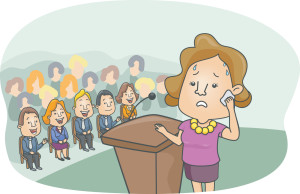As a professional speaker, I attend many conferences throughout the United States. Recently, I attended a luncheon with an audience of 500 business professionals. The speaker was a Vice President of a worldwide corporation with thousands of employees. My expectations for a highly informative and detail packed speech were high.
The speaker had content of interest to the audience but the delivery was horrible. Why do corporations send out people who represent them poorly? Our speaker could have spread corporate good will, community pride and enthusiasm. Instead, they droned on for an excruciating 40-minutes.
Common Mistakes that Non-Professional Speakers Make
- Dependence Upon Filler Words: Examples of fillers are “uh”, “um” “and” “you know” and “so.” The speaker used the word “uh” over 100 times in 40-minutes. That’s 2 ½ “uh’s” every minute.
- The 100-Word Sentence. Excessive dependence upon the conjunctions “and” or “but” to string idea after idea into a boring soliloquy.
- PowerPoint Boredom. Each Slide was on the screen a minimum of 1 minute 20 seconds. That is too long to stare at the same screen with 20 or fewer words on it. Think of how long a 60-second commercial feels. We have become a nation with short attention spans.
- I Can Read. The Speaker recited the words on the slides to the audience. The audience was of an educational background that one could assume had the capacity to read.
- Give ‘em the Cold Shoulder. The speaker turned away from the audience and towards the screen, to read from the slide. The speaker flashed the “cold shoulder” every 1 and ½ minutes.
- Repetition. An effective technique, used by many professional speakers’ politicians and religious leaders. This speaker clearly was ill-prepared and lacked confidence.
- Don’t Read to Me. The only time the speaker did not use filler words was when they were reading directly from their prepared remarks. The “script” is an outline.
- Smile. An occasional smile helps to gain the audience’s attention, empathy and respect.
- Be Excited About the Topic. If the speaker was as bored with the presentation as the audience grew to be, we could have all gone home after coffee and dessert. No Harm, No Foul
- No Humor. A stand-up comedy routine was not expected. However, the question is often asked: “Does a speaker have to be humorous?” The answer is No, not unless they want to: A. Get Paid. B. Connect with the Audience. C. Be Remembered or D. Cause a change attitude, actions or point of view.
My next blog will give you some helpful tips. Be prepared for the next time you find yourself speaking in front of a small group, board meeting, your staff, a jury or even scarier, an audience.


